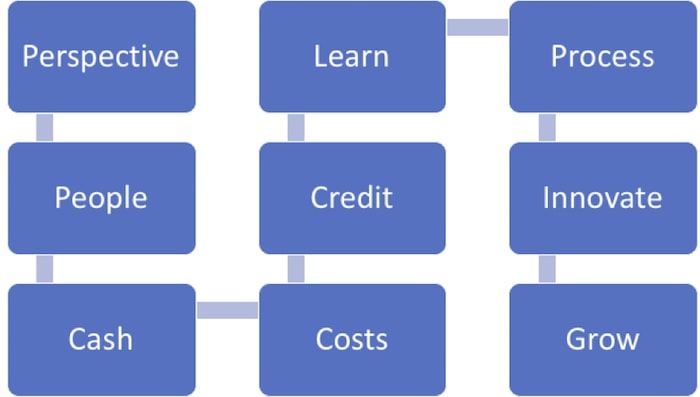“The pessimist sees difficulty in every opportunity. The optimist sees opportunity in every difficulty.”
—Winston Churchill
These are special times that are challenging for all of us. In this issue, I’ve worked hard and created 51 ideas in this newsletter for you to use to help you protect your business, pursue opportunities, and build your business wealth. Please let me know if you’ve found other tactics to be useful, as well, and I’ll add them to my list.
Every business owner I know has been through a crisis or two. Some are self-inflicted, some are caused by others or events beyond anyone’s control. The solution is obviously not to set blame.
In a crisis, the need—and opportunity—is to survive, get stronger, prevent or mitigate the impact in the future, and thrive in the long term.
From my experience, the most important strategies and tactics to protect your business, your employees, your customers, and your families are focused on strengthening the basics in your business.
Executive Summary
To protect and strengthen your business:
- Focus on helping your people stay connected and provide as much value as possible to others.
- Maintain financial reserves so you’re not chasing cash but actually able to implement proactive strategies.
- Educate your customers and prospects about your strengths, your accomplishments, and how you can help them.
- Take care of yourself: physically, mentally, socially.
- We’re all in this together.
- This, too, shall pass.
Figure 55.1 Protecting your business

Perspective
- Keep perspective with factual data. For example, there were no new cases of Covid-19 discovered in China on a recent day. The trend is improving after only two and a half months since it started.
- We are being proactive to minimize the spread and reduce the negative impact. Right now, the situation is more about disruption.
- Take control and do what you can to “flatten the curve.”
- Be proactive to protect your business.
- If you find yourself in denial, or angry, or trying to negotiate with reality, talk to someone to help you understand and accept reality, and then get on taking action and dealing with.
- Taking action reduces stress and gives you more control over the situation.
People
- Proactively communicate with your employees, customers, suppliers, bankers, investors, and family members.
- Share your plans for the short-term and long-term based on factual data and calm reasoning.
- If you’re highly stressed, talk to your advisors before making any major decisions.
- Personally, I never make major decisions after 4:00 pm, when I’m tired, or when I’m worried about something.
- Fear and stress do not increase our intelligence. In fact, when we’re stress, and the body is producing chemicals to help you “fight or flee” there is less blood flowing to your brain.
Cash
- You can quote me on this: “Cash isn’t king, it’s the ace.” Protect cash in your business.
- Create cash in your business by accelerating your Total Days to Cash inflow, slowing or reducing your outflows, and ensuring your cash investments generate a positive return on investment for you.
- Obtain deposits on major orders to maintain positive working capital.
- Don’t finance your huge, multinational clients. They have access to a lot more cash than you do.
Costs
- Decrease all discretionary expenses that don’t take care of your customers or employees.
- Streamline your labor as quickly as possible. There are support mechanisms in place if people need employment insurance support.
- Negotiate temporary relief on all major contracts and fixed expenses, such as rent, mortgage payments, or loan payments (ask for interest only payments).
Credit
- Hopefully, you’ve maintained a positive and proactive relationship with your banker. The longer and stronger your banker relationship, the easier and better your life will be.
- Share your plans and ideas with your banker. Ask them for feedback. They have the unique and powerful perspective of seeing many industries go through a variety of ups and downs. They’ve been through this before. They are a valuable partner.
- Ask your suppliers for extended terms. Keep sending them something each month, so they know you remember them.
- Don’t buy capital assets with operating cash. Always match your financing type to the asset’s useful life. For example, obtain a mortgage to finance a building. Obtain a loan or lease to finance equipment.
Learn and Teach
- Identify your most critical processes and ensure they are properly documented (see Process below).
- Capture the experience and expertise that exists in your company as tribal knowledge but is not written down. Write it down.
- A very important part of marketing is to share our knowledge and experience with our customers, so they know what we know.
- Our brains learn and process information visually much more quickly than through text, numbers, or bits and bytes. Use pictures and videos often.
- Take specific marketing actions to share your knowledge and to educate your customers about all the ways you can help them.
- Take ‘before and after’ photos to show how you improve your customer’s situation.
- Create ‘before and after’ videos to show you can dramatically create better realities for your customers. Add some sound and voice overs, and you’ll have a very professional piece that can educate customers and prospects 24/7.
- Ask your customers for short video testimonials using a case study format: 1) what their situation was, 2) how you helped, and 3) what their results were.
- Post your customer testimonials on your website using written letters or emails, photos, and videos, everywhere possible.
- Remember, it’s not bragging if you can do it. And not everyone can do it.
- Even if your work is easy for you, it’s not easy for anyone else. That’s the power of aligning your talents and your strategy…you make things look easy.
- Go to where the business is. Don’t limit yourself to your local geography.
Process
- If you’re like most mid-market companies, there is a lot of company history and knowledge between your (and your employees’) ears. If you haven’t already done so, this is definitely a time to codify your systems and procedures.
- Document your systems by focusing on the most important and critical systems first.
- Make the creating of system documents the responsibility of employees who perform the tasks. Partner them with someone else so they get cross-trained and the other employee can ask questions about obvious steps.
Innovate
- Look for bottlenecks and stress points in your business and figure out how to improve them.
- Figure out what your customers value most about your products and services and focus on delivering that. Eliminate things that take time or cost money and that don’t provide the value your customers want.
- Proactively call your customers and ask them what else they need. Then develop it and deliver it.
- Internalize what you learned about minimizing discretionary costs and optimizing cash flow and operations. Make sure these are written down and become an important part of your ongoing strategic plan.
- Review progress against your goals and update your strategic plan at least quarterly.
Grow
- Once things are more stable within your business, use this time to ensure you are strengthening your company. You can codify policies and procedures, improve financial performance, and increase the liquidity and valuation of your company.
- Spend time with your entire management team analyzing daily and weekly Flash reports on business performance in sales, production, and cash flow.
- Break down management silos and ensure everyone is looking at the same real-time and accurate Flash data at the same time.
- Simplify critical metrics in your business and share them visually with your team on a regular—weekly or monthly—basis.
- Set short term goals and measure progress against those goals.
- Adjust your plans on a regular basis.
- Management is about thinking. It’s about analyzing real data (not gut feel), making logical decisions (not best guesses), and comparing results (with real metrics) against your plans.
- If there are no metrics in your business, you can’t hold anyone accountable. If you use metrics, people cannot escape accountability.
- Your company, just like a team, wins or loses together. Make sure everyone is playing from the same game plan and using the same scorecard.

